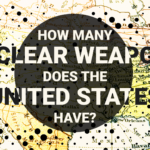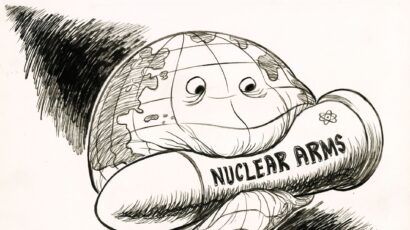Testing the test-ban treaty: Week two of the CTBTO inspection exercise in Kazakhstan
By Rebecca Johnson | September 19, 2008
As the on-site inspection of the former Arcanian test site entered its second week, the inspection team from the Comprehensive Test Ban Treaty Organization (CTBTO) has begun to narrow its search for evidence on whether or not Arcania conducted a recent nuclear weapon explosion in violation of its obligations as a state party to the Comprehensive Test Ban Treaty (CTBT).
Despite atrocious weather that delayed helicopter overflights and some field work, the CTBT on-site inspection has sent teams into the designated inspection area every day. As part of its generous support of the on-site inspection field exercise, Kazakhstan's Ministry of Emergency Situations has provided a helicopter and pilots. As lashing rain gave way to sunny days with a strong gusty wind, the overflights were able to start. Each overflight has to be meticulously planned and agreed with the inspected state party–in this case, Arcania. True to their role, the Arcanian representatives are being awkward, restricting access to certain areas for "national security"–or so they say.
Every aspect of this on-site inspection must be undertaken in accordance with the CTBT and its verification protocol. In addition, a draft on-site inspection test manual has been painstakingly negotiated by CTBT signatories. While the treaty's finalized text and protocol are regarded as the legal basis for the inspections, the manual sets out the agreed procedures. In addition to testing the technologies, techniques, and procedures for on-site inspections under the CTBT, an important purpose of this integrated exercise is to determine if the manual's provisions are appropriate–including whether the negotiators have achieved a practical balance between the rights, responsibilities, and needs of the inspection team and the inspected state party.
Here on the Kazakh steppes, we're experiencing a strange mix of reality and fiction. The reality is that this beautiful, bleak landscape is pitted with craters, shells of buildings, and debris from atmospheric Soviet nuclear tests conducted between 1949 and 1963. There are also boreholes from decades of underground nuclear explosions. After a series of local protests by the Kazakh Nevada-Semipalatinsk Movement, the Soviet Union stopped nuclear testing at Semipalatinsk in 1989, and in 1991, it declared a moratorium on further tests. The French and then the United States followed with their own moratoria, paving the way for the CTBT negotiations in the mid-1990s. In the real world, though, the CTBT hasn't yet entered into force, despite attracting 179 signatories and 144 ratifications.
But in this integrated field exercise, the scenario assumes that the treaty has indeed entered into force, the verification regime is up and running, and a seismic event near Arcania's former test site has caused sufficient suspicion for an inspection to be launched. During their first week, the inspectors used three techniques–visual observations, seismic measuring, and radionuclide detection– to build a general picture. The inspectors did not pick up aftershocks of relevance that might have helped them focus on a particular area. Nor has the evidence supported Arcania's justification that the seismic signals detected by the International Monitoring System on August 22 came from a shallow earthquake. Some radiation hotspots have been identified, but most of these appear to relate to pre-CTBT nuclear tests. But visual observation has picked up some interesting features, and the inspectors are now directing their attention to specific areas where they want to take a closer look.
Attention to health and safety is extremely high. Everyone at base camp has a dosimeter, which we're instructed to wear at all times. In addition, we must don personal protective equipment if we undertake any fieldwork in the test site, including masks if soil or vegetation are to be disturbed by sampling. In case there is a problem, a local health physicist familiar with the Semipalatinsk conditions accompanies the away teams. When the teams return to base camp, all personnel and equipment are subjected to rigorous checks by radiologically trained health workers at the decontamination tent before being allowed back into the camp. The prognosis–so far, so good.
Having finally managed to conduct some visual surveys after the weather improved enough for the helicopter to take off, the inspection team followed up with requests to fly over the inspection area with sensitive equipment to measure for gamma radiation. After several rounds of negotiations between the leadership of the inspection team and the Arcanian representatives, the gamma flights were allowed over the "no fly zone," but the inspection team members were forbidden to bring cameras or binoculars. At one point, there was even talk of fixing blinds to all the windows so that the helicopter's occupants wouldn't be able to see anything outside. But pragmatism prevailed, not least because a bumpy ride was expected, and a helicopter ride with blacked-out windows isn't fun for anyone. As an observer along for one of the gamma-inspection flights, I was especially grateful to be able to gaze out of the windows as flat plains and rocky hills undulated below, occasionally disturbing small herds of animals.
The integrated field exercise will reach its midpoint on September 13. For the most part, the equipment seems to have performed well, but much of it still needs to be further tested and evaluated. Drawn from more than 30 countries, the inspection team, led by Wang Jun, has never worked together like this before, and although there have been field exercises to test specific types of equipment, this is the first time that the CTBTO's provisional technical secretariat has tried to pull together the range of technologies into a month-long integrated exercise in real test-site conditions. Therefore, it's fascinating to see unfold the human dynamics that would be so important to the success of any on-site inspection.
When the CTBTO's on-site inspection provisions were being negotiated in Geneva, it was thought that they were unlikely ever to be evoked. And yet, it was still necessary to get them right in order to achieve the proper balance between what was sufficient to ensure that noncompliance would be detected and what was politically bearable for the states parties who might find themselves the subject of an inspection request. As demonstrated by its detection and identification of the 2006 North Korean nuclear test, the International Monitoring System is now sufficiently comprehensive and sensitive enough to act as a major deterrent to cheating; in other words, the likelihood of getting caught is high.
But deterrence doesn't always work. On-site inspections may be rare, but they have to be robust and rigorous enough to provide confidence that treaty violations will be caught. Otherwise, it could be too tempting for a country to cheat and claim some other source for any seismic signals or radionuclides detected by the International Monitoring System. Thus, this integrated field exercise is taking place at a multiple interface between verification politics and technology, theory and practice, and fact and fiction.
As night falls and myriad stars fill the black sky, I'm struck by the poignancy of being at one of the world's most heavily used test sites for the purposes of testing inspection technologies intended to ensure that no country ever conducts another nuclear explosion. One Russian participant pondered over lunch that during the Cold War, he had come to Semipalatinsk to participate in testing nuclear weapons because he believed they were necessary for peace and now he's here again to test treaty-verification capabilities that he thinks are vital for security and peace.
Together, we make the world safer.
The Bulletin elevates expert voices above the noise. But as an independent nonprofit organization, our operations depend on the support of readers like you. Help us continue to deliver quality journalism that holds leaders accountable. Your support of our work at any level is important. In return, we promise our coverage will be understandable, influential, vigilant, solution-oriented, and fair-minded. Together we can make a difference.
Topics: Nuclear Weapons















